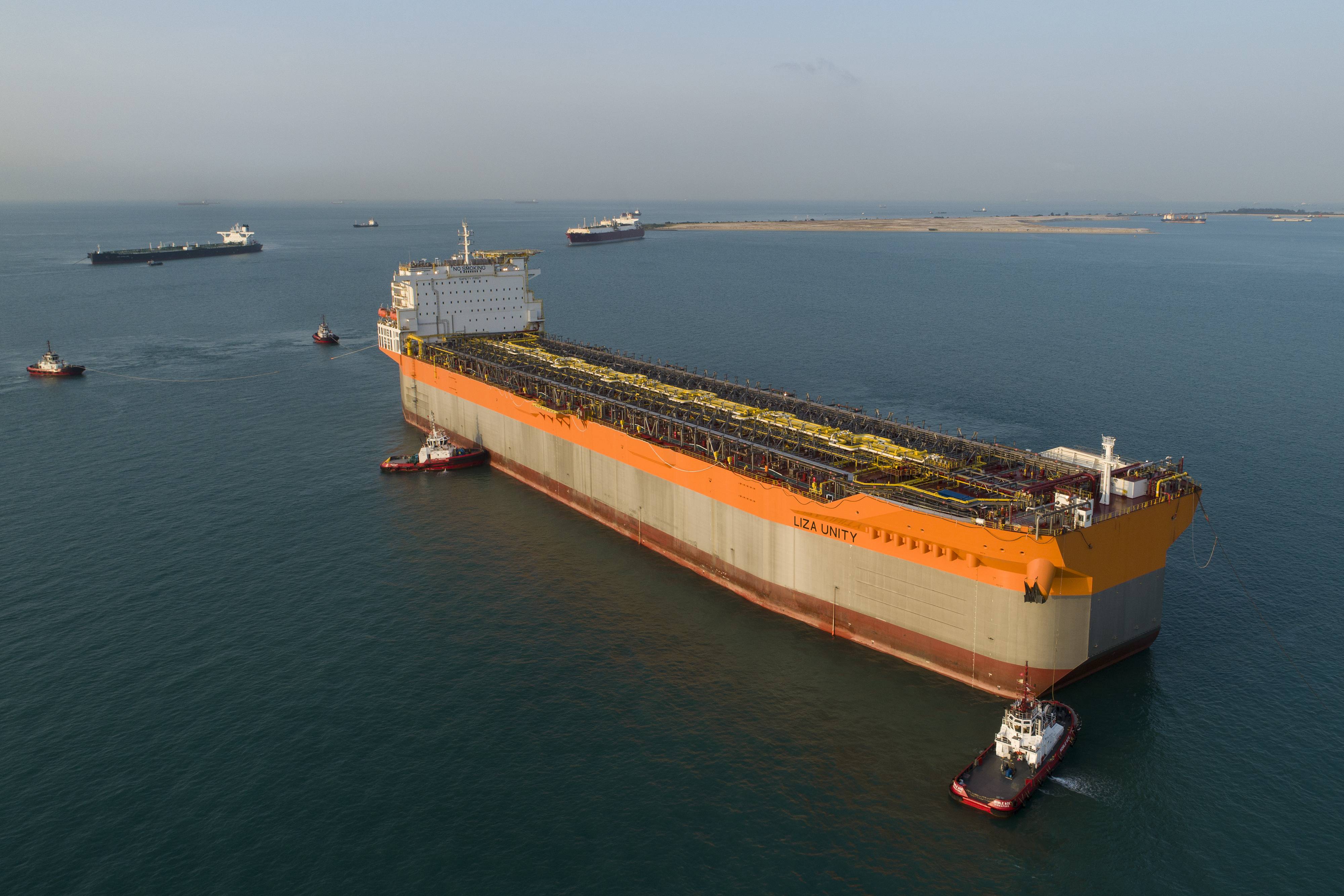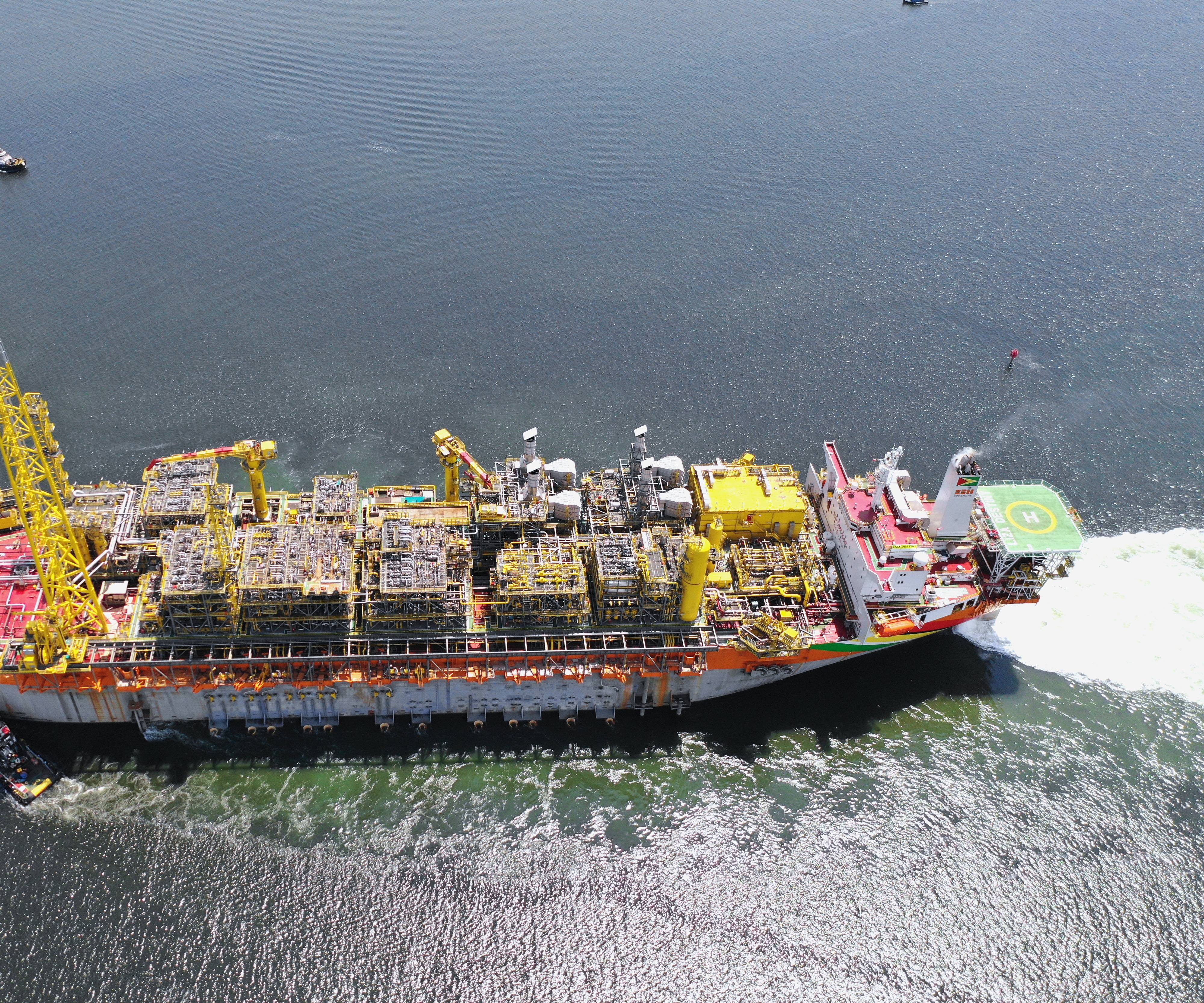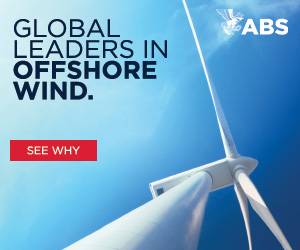Cover Feature
Floating Production
Floating Production’s Bull Run
Offshore floating energy production is on a growth path, with two important energy production milestones hit in the ‘Golden Triangle’ of Latin America, Africa and the U.S. Gulf in late 2023. One is linked to oil production, 120 miles offshore Guyana, while the other is tied to gas production off the coast of West Africa.
By Barry Parker
Liza Unity sail away.
Photo by Charlie Xia/Copyright SBM OffshoreOffshore floating energy production is on a growth path, with two important energy production milestones hit in the ‘Golden Triangle’ of Latin America, Africa and the U.S. Gulf in late 2023. One is linked to oil production, 120 miles offshore Guyana, while the other is tied to gas production off the coast of West Africa.
Guyana has been in the news as oil behemoth ExxonMobil started production in mid-November 2023 at Payara, its third offshore oil development on the Stabroek Block at Guyana which it operates, with co-investors Hess Petroleum and CNOOC. This brought the company’s total production capacity in the country to approximately 620,000 barrels per day. “The Prosperity floating, production, storage and offloading (FPSO) vessel is expected to reach initial production of approximately 220,000 barrels per day over the first half of 2024 as new wells come online,” ExxonMobil said.
Two other FPSO’s – Liza Destiny and Liza Unity – similarly owned by Amsterdam-based SBM Offshore, have already been producing roughly 200,000 b/d each for ExxonMobil offshore Guyana. A fourth FPSO, One Guyana, capable of producing 250,000 b/d, will be coming onstream in 2025.
As always, geopolitics casts a cloud on energy production. In late 2023, Venezuela, drawing on a treaty from the late 1800s, was claiming title to the oil-rich Essequibo region of Guyana. ExxonMobil’s Global Energy Outlook published in August 2023 suggested that offshore Latin America production, presently at circa 3 mB/day, could ratchet upwards to 5 mB/day by the mid-2030s.



West Africa Looms Large
BP, another energy giant, will soon be deploying FLNG Gimi, a floating liquefied natural gas production vessel (FLNG), with a nameplate output potential of 2.7 million tons/year (mtpa) to work on its Greater Tortue Ahmeyim project, offshore Mauritania and Senegal, under a 20-year charter deal. The FLNG was originally a 125,000 cbm LNG carrier built in the mid 1970’s that underwent a conversion and was delivered in late November 2023 to owner Golar LNG from the Seatrium yard in Singapore, which absorbed the Keppel yard, where the work was done.
Its FLNG Hilli, also a conversion from the Keppel yard, has been working offshore Cameroon since 2018, with discussions for re-chartering underway as the current contract expires in mid-2026. Meanwhile, Golar LNG, which is actively pursuing opportunities offshore Nigeria, has acquired a 2004-built LNG carrier for conversion into a 3.5 mtpa FLNG.
Golar LNG’s 2023 third quarter results presentation indicates that its share of overall capitalization for FLNG Hilli has exceeded $1 billion. Following the financial results update, shares analyst Chris Robertson from Deutsche Bank wrote: “Once Hilli is re-contracted, it will undergo a period of significant downtime of between 6 to 12 months and depending on the location and duration of the next contract. Additionally, it could cost between $150 to $200 MM in incremental CAPEX to prepare Hilli for redeployment.”
Phil Lewis, Director of Research at Intelatus reports in a recently released White Paper on Floating Production that “more than 185 new floaters will be installed by the end of 2030, of which 70% will be FPSOs close to 20% FLNGs and floating production units without storage (semi-subs, TLPs and spars) over 10%.”
Besides being expensive, FPSO and FLNG deals have lengthy timelines, like Shell’s Prelude LNG which shipped its first cargo of the gas produced offshore Australia in 2019, eight years after the company took final investment decision (FID) on the unit.
Discussing a vessel coming of its present charter in 2026, Golar LNG explained to its investors that “a fully utilized FLNG Hilli has annual revenue potential in excess of $1 billion based on current LNG forward curves, to be shared between gas resource owners and Golar. Concluding a new charter for FLNG Hilli is therefore a commercial priority for the company.” This FLNG, with a capacity of 2.4 million tons/year, has been working offshore Cameroon since 2018. in late 2023, it loaded up its 100th LNG carrier. Discussing the potential conversion of its LNG carrier LNG Fuji into 3.5 million tons/year, Golar LNG told investors the following: “The cost of a converted FLNG Fuji is expected to be around $2 billion, equivalent to approximately $570 per ton. Financing proposals for between $1.2 to $1.5 billion… are being discussed.”
The “pipeline” for FPSO projects could be extensive. In its 2022 annual report, the owners of the vessels producing at Guyana SBM Offshore stated opinion that looking ahead, around 35 FPSO projects could reach FID between 2023-2025.
Not surprisingly, major hydrocarbon producers including ExxonMobil, Shell, Petrobras, CNOOC and Equinor, are providing the largest financial support for FPSO projects. One recent Petrobras deal shows their lengthy nature. Namely, in summer 2023, Japanese FPSO builder MODEC began production in the Campos Basin, under a 25-year charter on its newbuild Anita GaribaldiI MV33. According to MODEC “…the FPSO is capable of processing 80,000 barrels of crude oil and 7,000,000 cubic meters of gas per day and has a storage capacity of up to 1 million barrels of crude oil.”
The FLNG marketplace also offers tremendous potential. Earlier in 2023, analysts at Westwood Energy had pegged the size of the market, including projects gaining FID thru 2027, at $35 billion. More than half of these are in African waters. A relatively new entrant to the FLNG segment, New Fortress Energy, which describes itself as an LNG infrastructure provider, spun out of from infrastructure investor Fortress, is in the final stages of deploying its first FLNG as part of its “Fast LNG” program, which is essentially a modular approach to equipment construction.
The new unit, dubbed appropriately FLNG1, is capable of producing 1.4 million tons/year, off the coast of Altamira in Mexico and near Tampico. Soon to be online, the unit will be receiving gas from the Sur de Texas-Tuxpan pipeline, for export after reliquification. New Fortress Energy linked up with private investment funds run by Apollo to form vessel owner Energos Infrastructure, which acquired a fleet from a Golar LNG affiliate Golar Master Limited Partners. Up until early 2023, New Fortress Energy had also held a stake in FLNG Hilli.
Show Me the (LNG) Money
To financiers, LNG production projects are attractive as institutional capital providers. With lengthy contracts, a hefty portion of the cost can be “leveraged” with debt finance. Consider SBM’s activities in Guyana. Explaining the financing, lined up for its Prosperity in 2021, SBM Offshore said that “...it completed the project financing of FPSO Prosperity for a total of $1.05 billion … secured by a consortium of 11 international banks. The company expects to draw the loan in full, phased over the construction period of the FPSO. The financing will become non-recourse once the FPSO is completed and the pre-completion guarantee has been released. The project loan has a tenor of two years post completion, in line with the duration of the charter, and carries a variable interest rate plus 1.60%.”
The upcoming One Guyana unit has recently garnered an even larger project loan, $1.75 billion, secured by a consortium of 15 international banks. Taking advantage of a similar structure, it becomes non-recourse to SBM two years after it enters into service, through a structure known as a “Completion Guarantee”, with the project’s loan then repaid from its cash flows. Besides ExxonMobil, major FPSO users include Petrobras, producing oil offshore Brazil, China’s CNOOC and Equinor, which is active in the North Sea.
It is no surprise that institutional money packagers such as Apollo and Fortress, with long-term time horizons, are funding maritime projects. At a Marine Money event in New York held mid-2023, Energos Infrastructure CEO Art Regan, who has a lengthy tenure handling Apollo’s varied shipping investments, said: “The development of infrastructure funding into the shipping industry is a very good thing,” suggesting also that the energy transition, where long-term arrangements will be more of the norm, is bringing shipping into the “infrastructure realm,” along with utilities.
The roster of debt providers to Energos shows that the crossover from long-term project financiers to shipping assets, is real. Its debt financing, organized through an Apollo affiliate, was led by Brookfield Infrastructure Debt and also included a syndicate of other credit funds managed by Global Infrastructure Partners, HPS Investment Partners, and Carlyle Global Credit, along with Investec. Infrastructure type finance was also highlighted by Anastassia Tcherneva, Head of Shipping Finance at the ABN Amro bank, in a recent Maritime Impact webinar hosted by DNV. When asked about the shifting finance landscape, Tcherneva commented: “… for debt, you need to have also different sources of capital. That of seed capital, thinking that you mentioned that also infrastructure investors are getting increasingly interested in this sector. And the reason is that the energy transition is very much going to be there for time to come and people are looking for good yield versus the risk that they’re willing to take.”
Production platforms have been gaining FIDs from the big oil companies, with their mega balance sheets. In the U.S. Gulf of Mexico, Shell Offshore is moving ahead with its Sparta deepwater development in the Garden Banks field, 180 miles offshore Louisiana. The oil giant awarded Seatrium a contract to build the hull and topside for a semi-submersible Floating Production Unit (FPU) that will eventually produce 90,000 barrels/day.
With production forecasts pointing upwards, the market for drillships and deepwater semi-submersibles has also brightened. In a late 2023 regulatory filing, Valaris, a top participant in the deepwater and ultra-deepwater sectors- formed from a 2019 combination of Rowan and Ensco, explained: “In recent years, the more constructive oil price environment has led to an improvement in contracting and tendering activity for floaters. The number of contracted benign environment floaters has increased to 120 at September 30, 2023 from a low of 101 in early 2021, contributing to a 13% increase in global utilization… for the industry's active fleet over the same period. This increase in activity is particularly evident for 6th and 7th generation drillships, such as those included in our floater fleet. Utilization for the global active 6th and 7th generation drillship fleet is currently at 94% and has, on average, exceeded 90% for more than 12 months, resulting in a meaningful improvement in day rates for this class of assets.”
Securities analyst James West for Evercore ISI, who covers offshore drillers, including Valaris and competitors Transocean and Noble Energy, wrote in his end 2023 Offshore Oracle report: “Ultra-deepwater (UDW) marketed utilization is at its highest level since May 2015. UDW day rates have more than doubled off the bottom ... Incremental rig demand from key geographies has pulled idle assets from markets that have been slower to recover. Contract terms have lengthened and rigs are being contracted up to a year in advance.”
In the report, analyst West pointed to UDW day rates more than doubling to $500,000/day. On a January, 2024 webinar hosted by brokers BTIG, Simon Johnson, the CEO of Seadrill that boasts a diverse fleet of semisubmersibles and drillships, said: “The pricing has got so far to run. We are at the very beginning of the [cycle]”. In late December, SDRL booked two of its 6th generation drillships, West Auriga and West Polaris, on three-year contracts in Brazil, commencing later in 2024, at day-rates working back to levels around $500,000/day.
Market participants have been active - Valaris made a deal, worth around $390 million when mobilization costs are figured in, to acquire two high-spec drillships Valaris DS-13 and Valaris DS-14 from a South Korean yard. Showing the optimism pulsing through, Valaris will move the units to a shipyard in Spain - readily accessible to projects in the Golden Triangle - where it will “stack” them, while seeking out employment contracts. A few months earlier, in the third quarter of 2023, Valaris had lined up $400 million in 8.75% “add-on senior secured second lien notes” due in 2030. Investors’ optimism is palpable as this debt raise was “upsized” from the originally announced issue size of $350 million.



